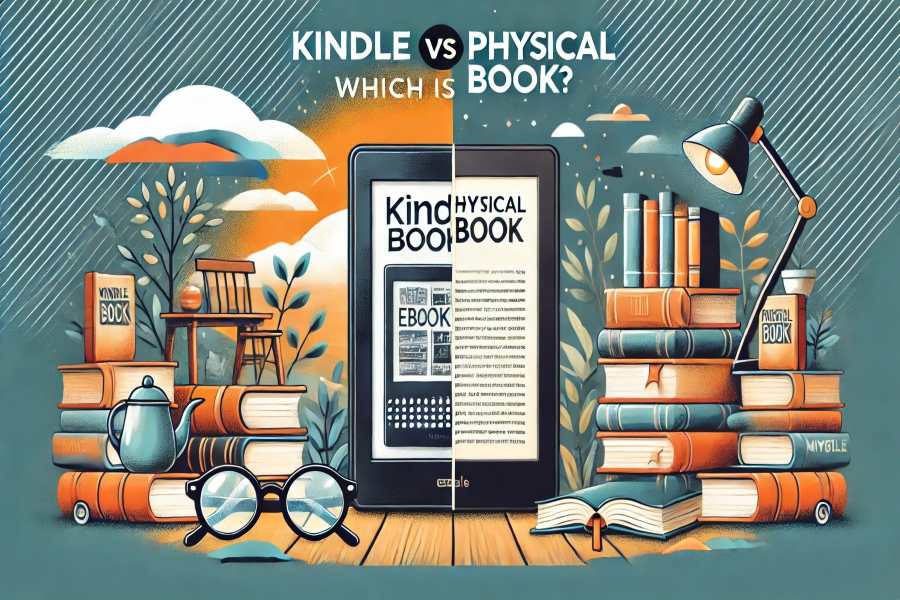In the digital age, the debate between Kindle vs physical books has become increasingly relevant. As avid readers and casual book lovers alike consider their options, the decision often comes down to personal preferences, lifestyle, and specific needs. Kindle offers a convenient and portable solution for reading, boasting a massive library at your fingertips. On the other hand, physical books provide a tangible, nostalgic experience that many readers find irreplaceable. This article delves into the pros and cons of both formats, helping you decide which is better suited to your reading habits and lifestyle.
Which Is Better: Kindle Or Physical Books?
Choosing between a Kindle and physical books depends on your preferences and reading habits. Kindles are convenient, portable, and can store thousands of books, making them great for travel. Physical books offer a tactile experience and can be easier on the eyes of some readers. Consider what aspects are most important to you to make the best choice.
Convenience Of Kindle Vs Physical Books
One of the primary considerations when choosing between a Kindle and physical books is convenience. This section explores the various aspects of convenience associated with each format, helping you understand which might better suit your lifestyle.
Portability
A Kindle can store thousands of books in one lightweight device, making it extremely portable. Whether you’re commuting, traveling, or just want to have multiple reading options on hand, a Kindle offers unparalleled convenience. In contrast, carrying multiple physical books can be cumbersome and impractical, especially for frequent travelers.
Storage Space
Physical books require significant storage space, which can be a challenge for avid readers with limited room. Bookshelves can quickly become crowded, leading to clutter. On the other hand, a Kindle eliminates this issue, as its digital nature means it takes up no physical space.
Accessibility
With a Kindle, you have instant access to a vast library of books, magazines, and newspapers. This instant gratification can be a major advantage for those who prefer to start reading immediately after discovering a new title. Physical books require a trip to the bookstore or a wait for online orders to arrive.
Reading in Different Environments
A Kindle’s adjustable lighting and font size make it adaptable to various reading environments. Whether you’re in a dimly lit room or outdoors in bright sunlight, a Kindle can be adjusted for optimal readability. Physical books, however, depend on external lighting and may not be as versatile in different settings.
Cost Comparison Between Kindle And Physical Books
1. Initial Investment
When considering the cost of a Kindle vs physical books, the initial investment in a Kindle device can be significant. However, this cost is offset over time as digital books often come at a lower price point than their physical counterparts.
2. Price of Books
E-books tend to be less expensive than physical books, which can lead to long-term savings for avid readers. Many classic titles are available for free or at a reduced cost in digital format, providing additional value.
3. Long-Term Savings
While the upfront cost of a Kindle may seem high, the potential for long-term savings on book purchases is substantial. Additionally, services like Kindle Unlimited offer subscription models that provide access to a vast library for a monthly fee, further enhancing cost-effectiveness.
4. Resale Value
Physical books can be resold or traded, recouping some of the initial investment. This is not an option with digital books, as they cannot be transferred or resold.
5. Library Access
Both Kindle and physical books offer access to library collections. Many libraries now provide digital lending services, allowing Kindle users to borrow e-books. This can be a cost-effective way to access a wide range of titles without purchasing them outright.
Reading Experience
- Tactile Experience: Physical books provide a tactile experience that many readers find irreplaceable. The feel of the pages, the smell of a new book, and the act of turning pages contribute to a unique reading experience.
- Eye Strain: Reading on a screen can cause eye strain for some people, especially during long reading sessions. Physical books do not have this issue, making them a better option for readers who experience discomfort with screens.
- Annotation and Highlighting: Kindles offer digital annotation and highlighting features, allowing readers to easily mark and save important passages. Physical books require manual highlighting and note-taking, which some readers prefer for their tangibility.
- Immersion: Some readers find that physical books offer a more immersive experience, free from the distractions of digital devices. The simplicity of a physical book can help readers focus and enjoy the content without interruptions.
Social And Cultural Aspects
- Reading Habits and Preferences: Reading habits vary widely among individuals, and the choice between a Kindle and physical books often reflects these preferences. Some readers prefer the convenience and modernity of an e-reader, while others cherish the traditional experience of a physical book.
- Cultural Significance: Physical books have a long-standing cultural significance and are often associated with learning, intellectualism, and tradition. They can also serve as decorative items, contributing to the aesthetic of a personal library or living space.
- Social Interactions: Physical books can foster social interactions, such as book swaps, lending, and discussions in book clubs. Kindles, while convenient, may lack the same social connectivity. However, digital book clubs and online communities can provide a modern alternative.
- Collectibility: For many, collecting physical books is a hobby and a source of pride. Rare editions, signed copies, and beautifully bound books hold sentimental and monetary value that digital books cannot replicate.
Conclusion
In the debate of Kindle vs physical books, both formats offer distinct advantages and disadvantages. The choice ultimately depends on individual preferences, lifestyle, and reading habits. Kindles provide unmatched convenience, cost savings, and accessibility, making them an excellent choice for tech-savvy, on-the-go readers. Physical books, on the other hand, offer a tangible, immersive experience that many readers find irreplaceable. By understanding the unique benefits of each format, you can make an informed decision that enhances your reading experience.
FAQs
1. Which Is Better For Long Reading Sessions, Kindle Or Physical Books?
Physical books are often better for long reading sessions as they do not cause eye strain, unlike digital screens.
2. Can I Read Kindle Books In The Dark?
Yes, Kindle devices have adjustable backlighting, allowing you to read in various lighting conditions, including the dark.
3. Are Kindle Books Cheaper Than Physical Books?
Generally, Kindle books are cheaper than physical books, offering significant savings over time.
4. Can I Lend My Kindle Books To Friends?
Some Kindle books can be lent to friends for a limited time, but this feature depends on the publisher’s settings.
5. Is It Better To Read A Kindle Or A Physical Book Before Bed?
Reading a physical book before bed is often recommended to avoid the blue light from screens, which can interfere with sleep.










Leave a Reply